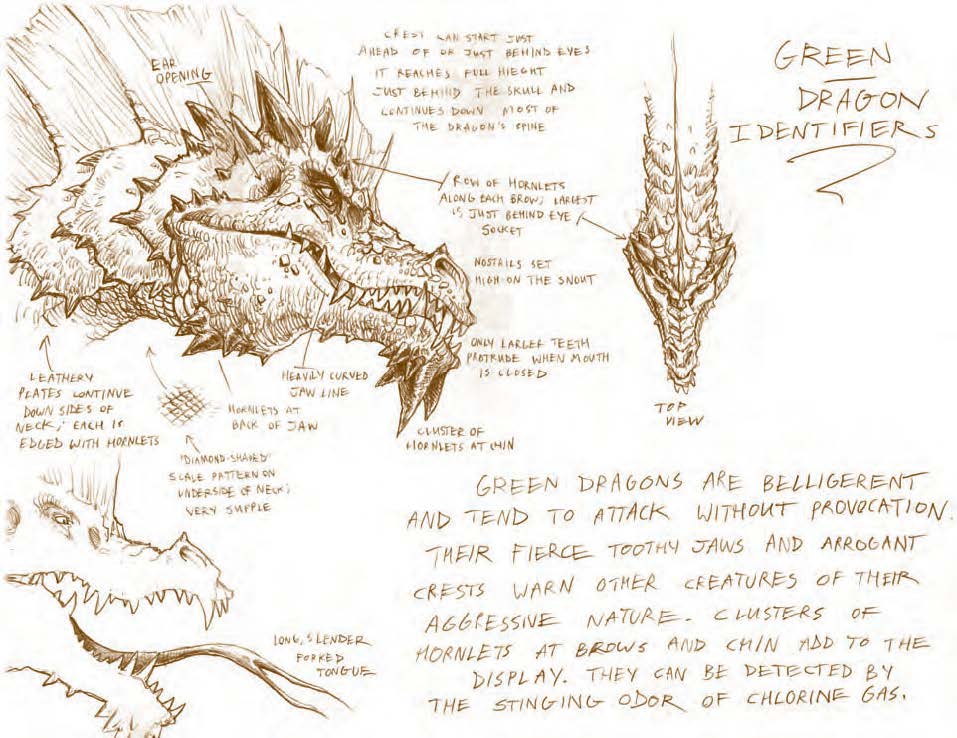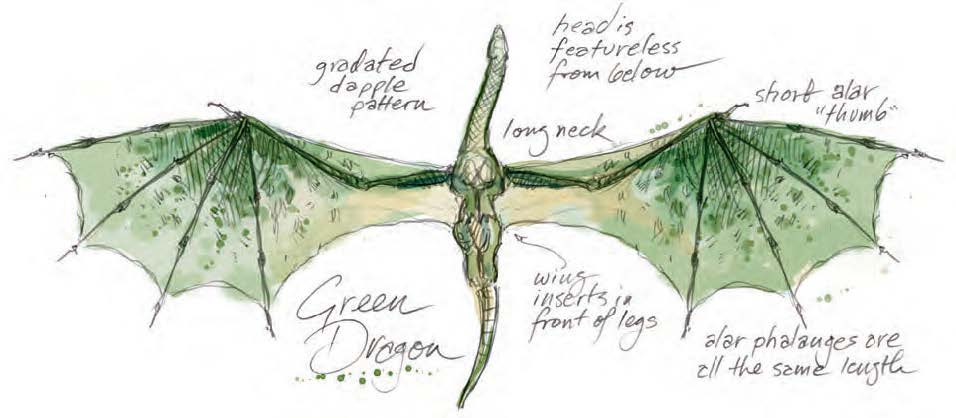Green Dragon
Green dragons are belligerent creatures and masters of intrigue, politics, and backbiting. They prefer forests; the older the forest and bigger the trees, the better. Green dragons are as territorial and aggressive as any other kind of evil dragon, but their aggression often takes the form of elaborate schemes to gain power or wealth with as little effort as possible.
Green dragons seek out caves in sheer cliffs or hillsides for their lairs. They prefer locations where the lair’s entrance is hidden from prying eyes, such as behind a waterfall or near a lake, pond, or stream that provides a submerged entrance. Older green dragons often conceal their lairs with plants they have magically grown. Green dragons sometimes clash with black dragons over choice lairs. The greens frequently pretend to back down, only to wait a few decades before returning to raid the black dragon’s lair and loot its hoard.
Dungeon-dwelling green dragons prefer locales with some kind of vegetable life, such as grottos filled with giant mushrooms.
Green Dragon Identifiers
A green dragon’s notable features include a heavily curved jawline and a crest that begins near the eyes and continues down most of the dragon’s spine. The crest reaches its full height just behind the skull. A green dragon has no external ears, just ear openings and leathery plates that run down the sides of the neck, each plate edged with hornlets. The dragon also has hornlets over its brows and at the chin. The nostrils are set high on the snout, and the teeth protrude when the mouth is closed. The dragon has a long, slender, forked tongue. The stinging odor of chlorine wafts from a green dragon. A wyrmling green dragon’s scales are thin, very small, and a deep shade of green that appears nearly black. As the dragon ages, the scales grow larger and lighter, turning shades of forest, emerald, and olive green, which helps it blend in with its wooded surroundings. A green dragon’s legs and neck are proportionately longer in relation to the rest of its body than any other chromatic or metallic dragon. When it stands on all fours, its body stays fairly high off the ground, enabling it to pass over brush or forest debris lying on the ground. The neck is often longer than the rest of the dragon’s body (excluding the tail), and older dragons can peer over the tops of mature trees without rearing up. A green dragon’s long neck gives it a distinctive, swanlike profile when aloft. The head looks featureless when viewed from below. The wings have a dappled pattern, darker near the leading edges and lighter toward the trailing edges. The alar thumb is short, and the alar phalanges are all the same length, giving the wingtips a rounded look. The trailing edge of the wing membrane joins the body well ahead of the rear legs.Habits
A green dragon patrols its territory regularly, both on the wing and on the ground, so as to get a good look over and under the forest canopy. These patrols serve twin purposes. First, the dragon stays on the lookout for prey. Although they have been known to eat practically anything when hungry enough, including shrubs and small trees, green dragons especially prize elves and sprites. Second, green dragons like to note anything new happening in their domains. They have a lust for power that rivals their desire to collect treasure. There is little a green dragon will not attempt to further its ambitions. Its favorite means of gaining influence over others is intimidation, but it tries more subtle manipulations when dealing with other dragons or similarly powerful creatures. Green dragons are consummate liars and masters of double talk and verbal evasion. Just talking to a green dragon can lead a being to ruin. When dealing with most other creatures, green dragons are honey-tongued, smooth, and sophisticated. Among their own kind, they are loud, crass, and generally rude, especially when dealing with dragons of the same age and status. Younger dragons are forced to use some restraint when interacting with their elders, but the veneer of civility they adopt is paper-thin, and the dragons know it. A clear pecking order, based on age and status but with no formal hierarchy, develops among green dragons within a given area. Green dragons know each other too well to depend on any formal social structure. Courtship among green dragons is a coarse and indelicate affair. Once a pair decide to mate, however, their lawful nature comes to the fore, and a strong bond develops between them. Parents take extreme care to invest their offspring with all the skills necessary for effective manipulation and double-dealing. A mated pair seldom leaves its first set of offspring untended, but may produce additional clutches to fend for themselves while the first clutch grows up. Once the first clutch reaches adulthood, the parents chase off the youngsters and go their separate ways. If the pair is about the same age, they divide their shared territory between them. (Such agreements usually last at least a few decades before the former mates seek ways to encroach on each other’s turf.) Otherwise, the younger parent leaves at the same time the youngsters do. Green dragons are not picky about the treasure they collect. Anything valuable will do. Among items of similar value, however, a green dragon favors the item that reminds it of a particularly noteworthy triumph. Green dragons often attack with little or no provocation, especially when dealing with creatures passing through their territory. (Such creatures don’t offer much opportunity for a scam or other long-term manipulation, so the dragon simply attacks.) Victory in such an encounter often nets the dragon some treasure and helps demonstrate the dragon’s power to its neighbors and subjects. The dragon typically stalks its victims, studying them from afar and planning its assault. It may shadow its victims for days before attacking. If the target appears weak, the dragon makes its presence known quickly—it enjoys evoking terror. A green dragon seldom slays all its opponents, preferring instead to try to establish control over one of the survivors by using intimidation or magical enchantments. It then questions its prisoner to learn what is going on in the countryside, and if there is treasure nearby. Green dragons occasionally release such prisoners if they can arrange for a ransom payment. Otherwise, the prisoner must prove its value to the dragon daily or die.Sources:
- Dungeons & Dragons Draconomicon (3.5 Edition, 2009).
- Monster Manual, Green Dragon
Related Ethnicities




Comments